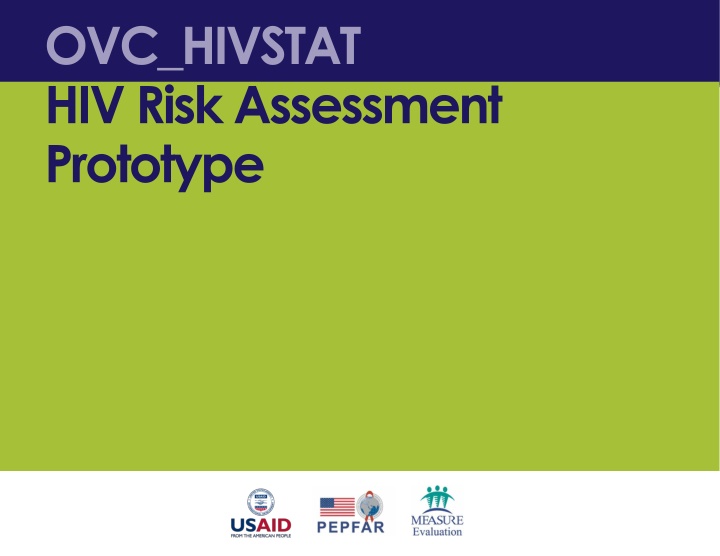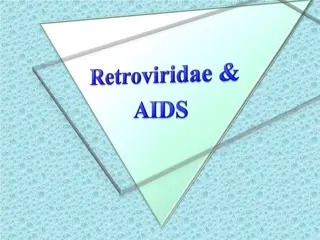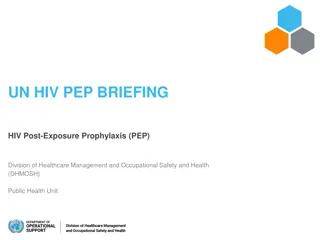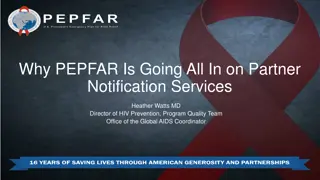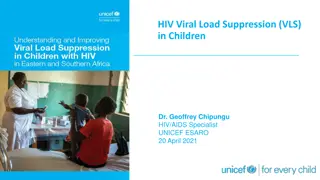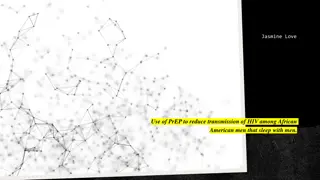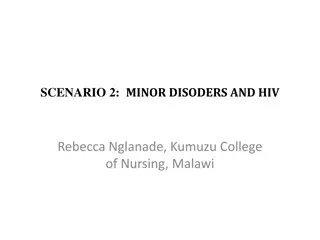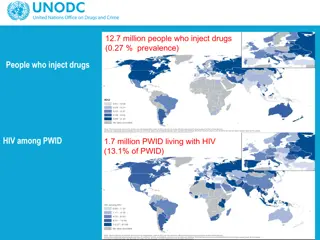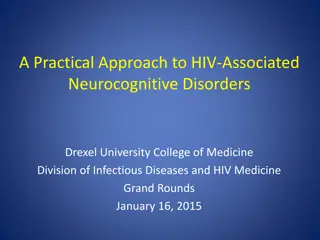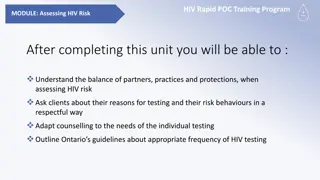HIV Risk Assessment Prototype for OVCs
In the effort to enhance targeted HIV testing and care for vulnerable children, the HIV Risk Assessment Prototype aims to identify at-risk children for HIV infection efficiently. Developed by MEASURE Evaluation, this customizable tool helps IPs in capturing and organizing crucial data to ensure better reporting and follow-up care. The prototype includes suggested templates and risk questions to streamline the assessment process and improve outcomes for OVCs under 18.
Download Presentation

Please find below an Image/Link to download the presentation.
The content on the website is provided AS IS for your information and personal use only. It may not be sold, licensed, or shared on other websites without obtaining consent from the author.If you encounter any issues during the download, it is possible that the publisher has removed the file from their server.
You are allowed to download the files provided on this website for personal or commercial use, subject to the condition that they are used lawfully. All files are the property of their respective owners.
The content on the website is provided AS IS for your information and personal use only. It may not be sold, licensed, or shared on other websites without obtaining consent from the author.
E N D
Presentation Transcript
OVC_HIVSTAT HIV Risk Assessment Prototype
HIV Risk Assessment prototype Background In the current climate of limited resources, there is a desire to reduce overall testing costs while strategically targeting testing to those most likely to test HIV-positive. As part of that push, the Office of the Global AIDS Coordinator (OGAC) recommends that an HIV Risk Assessment be applied to all children whose HIV status is unknown, to identify children at risk for HIV infection and subsequently ensure that they are tested. In addition, implementing partners (IPs) should play a key role ensuring that HIV-positive children are successfully linked to and retained in treatment and care. 2
HIV Risk Assessment prototype Introduction After reviewing many IP HIV risk assessment tools, MEASURE Evaluation noticed key issues with how data were captured and organized. MEASURE then developed an HIV Risk Assessment prototype that IPs may adapt to assess risk among orphans and vulnerable children (OVC). The purpose of the prototype is to improve the quality of data collected for reporting to the Data for Transparency and Impact (DATIM) system of the United States President s Emergency Plan for AIDS Relief (PEPFAR). Efforts are ongoing to study the appropriate mix and type of risk questions, to enhance the ability of case workers to refer the children whose risk is highest. 3
HIV Risk Assessment prototype Suggested template that can be modified for use by IPs IPs will add their own risk assessment questions (gray boxes) Ideal if all IPs in one country are using the same tool 4
HIV Risk Assessment prototype Intended use This HIV Risk Assessment is intended for OVC under 18 years of age for reporting data on PEPFAR s OVC_HIVSTAT indicator and is entirely customizable. 5
HIV Risk Assessment prototype Current HIV status Determine whether or not the caregiver knows the HIV status of the child. For HIV-positive children, the Antiretroviral treatment (ART) Assessment is conducted separately. Determine whether or not HIV-negative results were reported within the past 6 months. 6
HIV Risk Assessment prototype HIV risk questions HIV risk questions are to be added as appropriate. Suggest simple logic: If the answer to at least one question is yes, then the child is considered to be at risk. Note clear labeling of the outcome of the risk assessment. Suggested Q1: Does the child have an HIV-positive parent or sibling? 7
HIV Risk Assessment prototype Progress monitoring and new HIV status Gather information on the next steps for monitoring and recording a new HIV status after the HIV Risk Assessment. Encourage attaching the date to each key step. Consider tracking two types of HIV status: original and current. 8
HIV Risk Assessment prototype Data entry This data entry map helps data entry clerks know what results on the form correspond to which DATIM categories. Red fields map to HIV status unknown. Green fields mapto HIV positive, HIV negative, , and test not required. 9
HIV Risk Assessment prototype Data entry: Original HIV status If the caregiver doesn t know the HIV status of the child or the child had an HIV-negative test done more than 6 months ago Conduct the risk assessment starting with the first question. No data entry in this section. If the caregiver knows the status of the child and the child is HIV-positive Mark child's current HIV status as POSITIVE If the caregiver knows the child had an HIV-negative test less than 6 months ago Mark child's current HIV status as NEGATIVE 10
HIV Risk Assessment prototype Data entry: HIV risk assessment If the child is determined to be at risk but the test results are not yet reported. . . Mark child's current HIV status as TEST NOT REQUIRED If the child is not at risk 11
HIV Risk Assessment prototype Data entry: Progress monitoring and current HIV status If the child has been referred for testing, but the test results are not yet reported. . . 12
HIV Risk Assessment prototype Data entry: Process entry and current HIV status If the child has completed an HIV test and results are reported Mark child's current HIV status as Positive OR Negative If the child has completed an HIV test, but the test results are not yet reported or disclosure is refused. . . 13
Best practices for adapting the HIV Risk Assessment prototype 1. Include only risk factors that require testing. 2. Use a simplified form structure that has clear selection options for yes and no after each question and a clear location to mark the result. 3. Keep the assessment to one page per child. 4. On the same one-page tool, include next steps and follow-up after administering the assessment. 14
HIV Risk Assessment prototype Conclusion IPs are encouraged to collect internal monitoring data to ensure that they continually improve linkageto HIV testing services for those children most at risk of infection. Children drop off the HIV risk assessment continuum at multiple stages. All children who drop off should be reported under OVC_HIVSTAT as HIV status unknown. 15
This presentation was produced with the support of the United States Agency for International Development (USAID) under the terms of MEASURE Evaluation cooperative agreement AID-OAA-L-14-00004. MEASURE Evaluation is implemented by the Carolina Population Center, University of North Carolina at Chapel Hill in partnership with ICF International; John Snow, Inc.; Management Sciences for Health; Palladium; and Tulane University. Views expressed are not necessarily those of USAID or the United States government. www.measureevaluation.org
